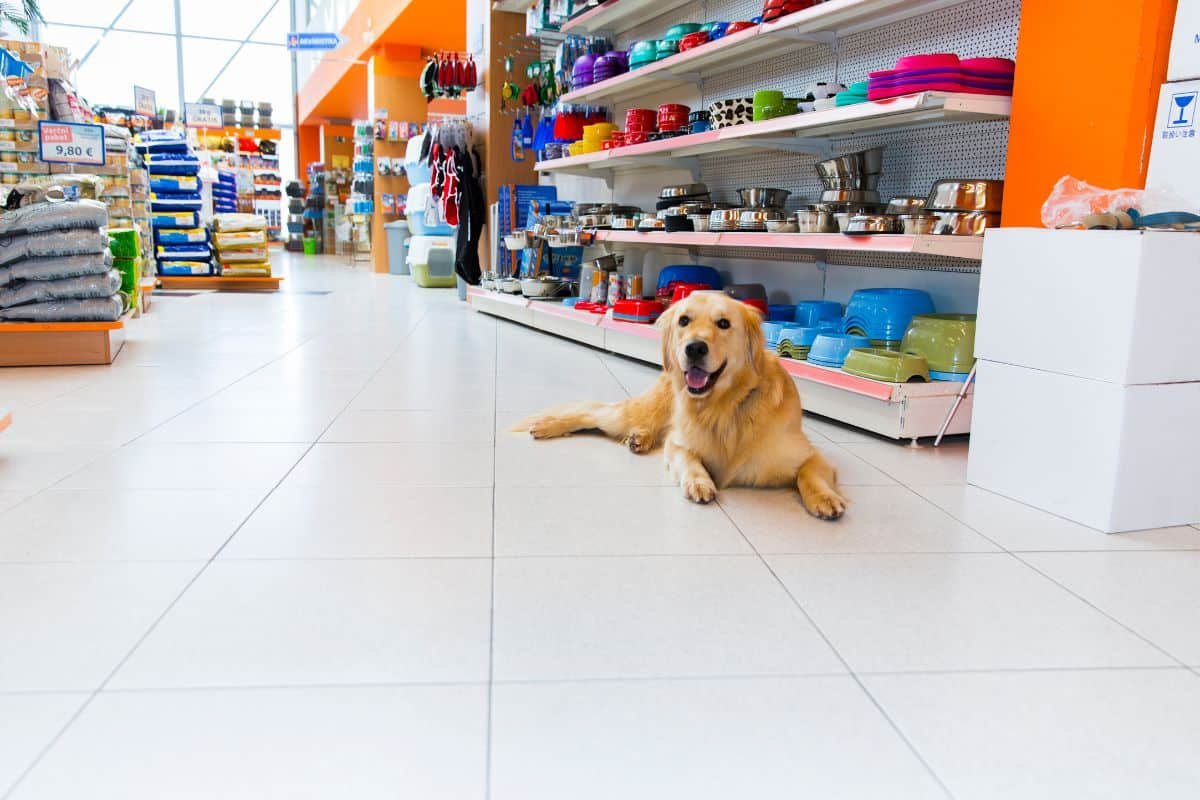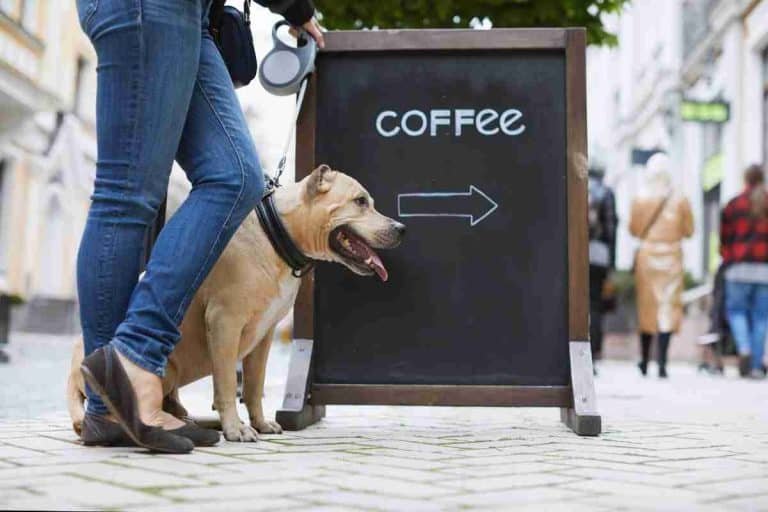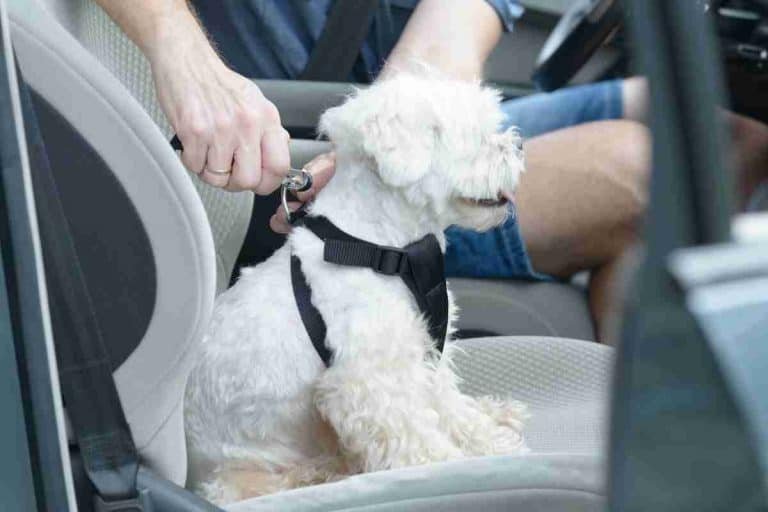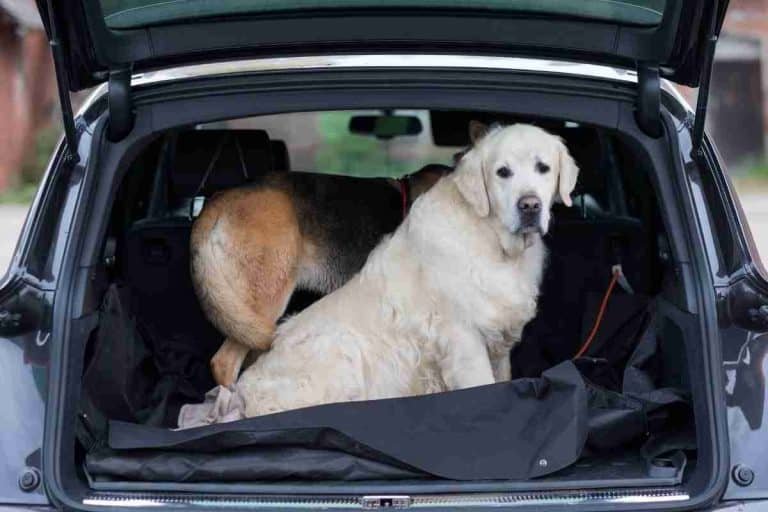Are Dogs Allowed in Cabela’s? Complete Dog Policy, Exceptions & Tips
Last Updated on September 16, 2025
Are dogs allowed in Cabela’s? Often, yes—on leash and well behaved. Service animals must be admitted under the ADA. Pet dogs depend on the specific store, local ordinances, and any mall or food-service restrictions. Calling ahead prevents surprises at the door.
This guide covers exceptions, ESA differences, leash rules, behavior expectations, and areas off‑limits. Shoppers will find quick scripts to confirm a location, etiquette tips to avoid refusal, and backups like curbside pickup.
Quick answer and Cabela’s core dog policy
Cabela’s does not have a blanket nationwide ban on dogs. Many locations allow leashed, well-behaved pet dogs on the sales floor, while corporate guidance emphasizes welcoming customers and safety. Service animals that meet the Americans with Disabilities Act (ADA) definition must be permitted in public areas regardless of local pet rules.
Retail chains vary in how they publish policies. Some stores post clear signs; others handle questions at the entrance. Because local ordinances, mall rules, or food-service areas can restrict pets, customers should verify before visiting. Calling the store or checking its local webpage avoids surprises and potential refusals at the door.
For a comparison of how large retailers handle pet policies, see Are dogs allowed in Costco? Customers planning an in-store visit should call ahead and confirm whether the specific Cabela’s location permits pets. This simple step prevents wasted trips and protects the dog’s comfort.
Short summary: are dogs allowed inside
The short answer: service animals are allowed; pet dogs may or may not be allowed depending on the store. Many Cabela’s stores welcome on-leash dogs in retail areas. Staff may deny access when a dog poses a safety risk, displays aggressive behavior, or the facility is part of a landlord’s restriction.
Shoppers should follow basic in-store etiquette: keep the dog leashed, under control, and calm. Owners must clean up after accidents and remove dogs that bark or become disruptive. If a store forbids pets, ask whether entrances, outdoor displays, or nearby pet-friendly areas exist.
Public-transport and venue etiquette often overlaps with in-store rules. For broader guidance on taking a dog into public spaces and how to prepare the dog, consult Traveling with your dog by train: tips and tricks. When unsure, call the specific Cabela’s store before bringing a dog inside.
How corporate guidance and local store rules interact
Corporate guidance sets a baseline and legal obligations. Local managers implement those rules day to day. That creates variation between stores in different states, malls, or standalone locations. Store-level restrictions often come from landlords, building codes, or municipal health rules.
When a Cabela’s sits inside a shopping center, mall rules may supersede corporate pet allowances. If a location includes food-service counters or an indoor café, it may prohibit pets in those areas even if it permits dogs in general retail spaces. Managers have discretion to enforce safety-related exceptions.
Plan ahead: call the store, verify whether pets are allowed in all areas, and ask about any seasonal or event-based restrictions. If the store cannot admit a pet, owners can use options covered in travel-planning guides, like arranging short-term care or using curbside pickup. See practical preparations in Essential dog travel tips and gear for road trips.
Difference between service animals, emotional support, and pet dogs
The law treats these categories very differently. A service animal under the ADA is a dog individually trained to perform specific tasks for a person with a disability. Businesses must allow such animals in public areas. Staff may ask only two questions: whether the dog is a service animal and what task it performs. They cannot demand proof or require specific identification.
Emotional support animals (ESAs) do not receive the same public-access rights under the ADA. ESAs may have protections in housing or some travel contexts, but stores can treat them as pets. A pet dog has no legal right to enter a store unless the store’s policy or local law allows it.
If an owner plans to bring an ESA or pet into a store, call ahead and explain the situation. For travel distinctions and carrier rules relevant to animals in public venues and transportation, see Airlines that allow large dogs in cabin. When rights are unclear at the door, request to speak with a manager and remain calm. If a service animal faces improper refusal, note the manager’s name and consider contacting corporate customer service.
Where policies vary: states, provinces and individual stores
Cabela’s dog rules differ by jurisdiction and by store. Corporate guidelines set a baseline, but local laws, health codes and mall or plaza leases can change what a specific location allows. Shoppers should expect variation between states and provinces, and even between nearby stores in the same metro area. Stores in shopping centers with separate landlord rules often impose stricter limits than free‑standing locations.
Why some locations impose stricter rules (health codes, local laws)
Municipal health departments sometimes ban animals from retail areas that sell food or bait. Provincial or state public‑health statutes can also determine animal access. Local leash laws, animal control ordinances and liability concerns drive stricter store policies too. Stores near high foot traffic or in tourist districts may limit pets to reduce crowding and sanitation risks. Service animals remain protected by law in most places, but stores will follow local definitions when applying exceptions.
Common regional patterns and notable examples
Regions with strong outdoor cultures tend to be more pet‑friendly, while urban centers often restrict animals indoors. Northern states with many hunting customers may permit well‑behaved dogs more often. Conversely, locations in provinces with tight food‑safety rules frequently ban pets. Notable examples include outposts inside malls that follow mall policy versus standalone superstores with looser rules.
How to verify the policy for your nearest Cabela’s (phone, site, social)
Confirm the rule before visiting. Call the store’s direct line and ask about pets, service animals and outdoor leash areas. Check the store’s page on Cabela’s site and read the FAQ. Local store social media pages often post current guidance or temporary changes. For broader travel prep and alternatives to bringing a pet, see essential dog travel tips and gear for road trips. Call ahead when uncertain; it avoids surprises and ensures compliance.
Expectations for bringing a dog into the store
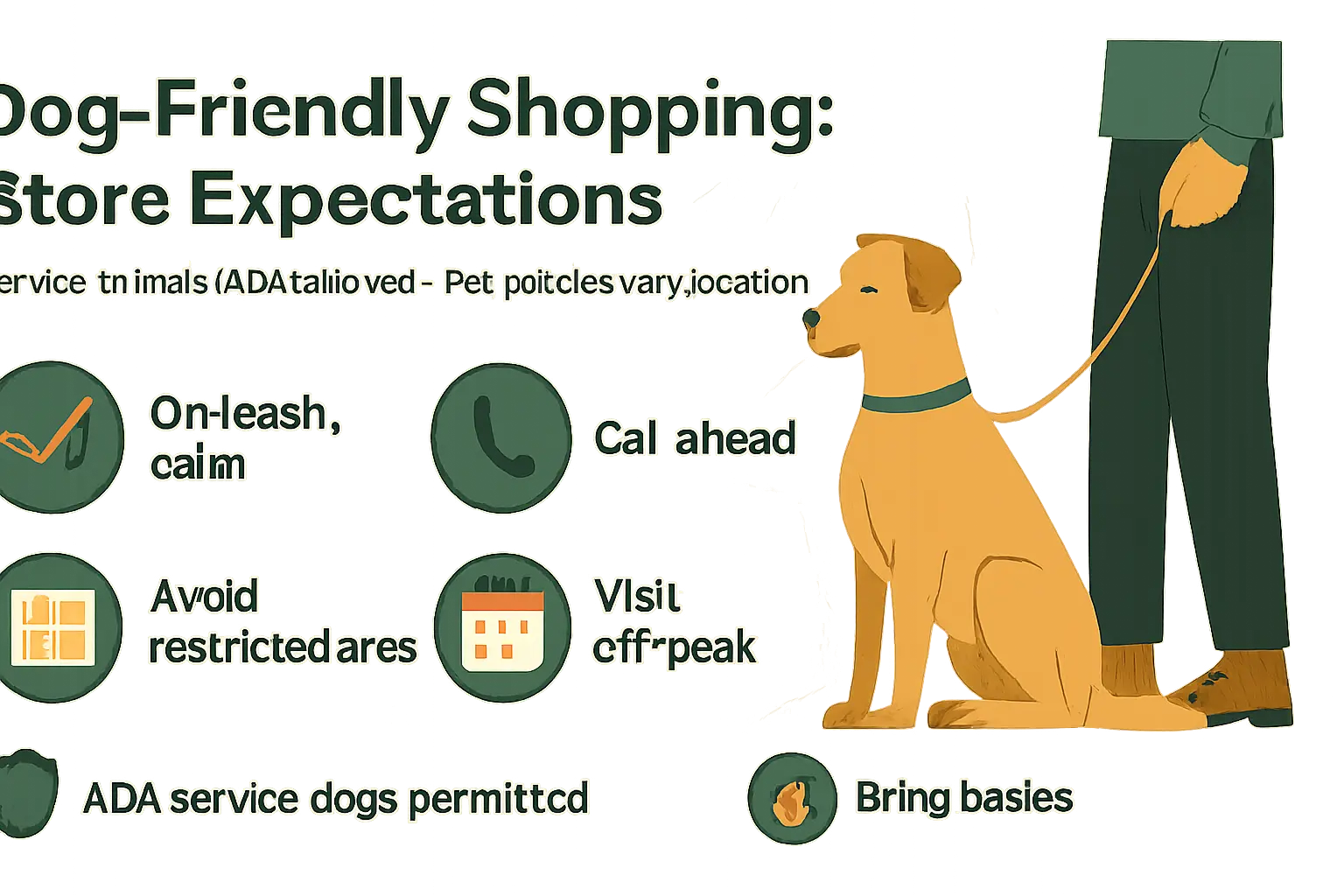
Cabela’s allows dogs at many locations, but policies vary by store and state. Service animals qualify under the ADA and receive broad access. Non-service pets depend on store management, local health rules and the type of store layout. Customers should expect staff to ask about a dog’s control, size and behavior before permitting entry.
Stores that permit pets typically expect owners to keep animals calm, on a short leash, and out of high-traffic displays. Some locations limit pet access during busy days, in promotional events, or near live-animal demonstrations. Hunting, fishing and firearm counters sometimes impose extra restrictions for safety.
Before arriving, verify the specific store’s rules online or call the local Cabela’s to avoid surprises. Bringing collapsible water bowls, waste bags and a quiet, well-behaved dog reduces refusal risk. For broader travel preparation and gear that helps make store visits smoother, see essential dog travel tips and gear for road trips.
Leash, control and customer behavior requirements
Cabela’s expects dogs to remain leashed and under immediate owner control at all times. Leashes should be short enough to prevent encroaching on other customers and displays. Retractable leashes often complicate control and may be discouraged.
Owners must prevent jumping, persistent barking, aggressive approaches to people or animals, and roaming aisles. Staff can request leash adjustments, removal from the sales floor, or that the owner secures the pet in a vehicle if behavior poses a risk. Children should never be left alone to manage a dog in-store.
If a dog shows signs of stress or unpredictability, management can require the dog to leave. Observing courtesy—yielding aisle space, avoiding food counters, and following staff directions—improves the chance a dog will be welcomed back. For tips on keeping a dog safely controlled during outings and car travel, consult how to secure a dog in car with leash.
Areas typically restricted to pets and reasons why
Even where pets are allowed, specific zones often remain off-limits. Commonly restricted areas include food service counters, indoor cafés, live animal or aquarium sections, shooting ranges, firearms service counters and certain display or demonstration spaces. These restrictions protect customers, animals and merchandise.
Reasons for limits include food-safety regulations, allergy and hygiene concerns, the risk of startling wildlife displays and legal liabilities around firearms or heavy equipment. Pets can also stress wildlife used in demonstrations or damage sensitive optics and gear. Store managers balance customer convenience with safety and regulatory compliance.
For context on how other big-box retailers handle pet access and how policies can differ between chains, see experiences compiled in Are dogs allowed in Costco? This comparison helps dog owners anticipate variations between locations.
Clean-up, vaccination and basic hygiene responsibilities
Owners must carry waste bags and clean up immediately after any accident. Many stores reserve the right to charge cleaning fees or require compensation for damage. Prompt, visible cleanup demonstrates responsibility and reduces store complaints.
While Cabela’s typically does not demand vaccination proof at entry, owners should keep core vaccinations, flea/tick prevention and parasite control current. Sick, heavily shedding or badly soiled animals are likely to be refused entry. Routine grooming before outings reduces shedding and odor issues.
If a pet soils the floor or inventory, notify staff right away and comply with cleanup or payment requests. Maintaining documentation for vaccinations and having a calm, well-trained dog ready for short visits lowers conflict risk. For practical tips on handling pet accidents during travel and cleaning a vehicle after a mess, consult dog poops in car.
Legal rights and staff interactions around service animals
Public accommodations, including retail stores, must follow federal rules that protect access for legitimate service animals. The law limits what businesses can require and how staff may interact. Owners must keep a service dog under control and remove it if it creates a direct threat or substantial disruption. Staff should respond calmly, verify facts within legal bounds, and document incidents that rise to a removal or safety concern.
Stores vary by state and franchise, so frontline employees should confirm company policy while respecting ADA standards. When planning a visit, owners can reduce friction by preparing the dog for crowded environments and confirming store access ahead of time. For practical travel and on-the-road prep, see essential dog travel tips and gear for road trips.
CTA: If a staff member doubts policy, they should contact management before insisting on removal.
Key points owners should know about ADA and service animals
The ADA defines a service animal as a dog trained to perform specific tasks for a person with a disability. Businesses must admit such animals into areas open to the public. Emotional support, therapy, or comfort animals generally do not meet the ADA standard for public-access rights.
Owners should keep the dog harnessed, leashed, or tethered unless such devices impede the animal’s work. The dog must remain under control, house-trained, and not pose health or safety risks. The owner carries responsibility for supervision, cleanup, and public behavior.
Local leash laws, health codes, and state regulations can add requirements beyond the ADA. For travel-focused guidance on public transportation and handling logistics, consult traveling with your dog by train tips and tricks.
What employees may ask and what they cannot request
When a person brings a dog that appears to be a service animal, employees may ask only two questions: whether the dog is a service animal required because of a disability, and what specific task the dog has been trained to perform. Staff may not demand documentation, proof of certification, medical records, or detailed description of the disability.
Employees cannot require vaccination records or special ID as a condition of entry. They cannot ask the animal to demonstrate its task. If the animal behaves aggressively or creates a legitimate safety concern, staff may insist on its removal. Staff should explain the reason for removal clearly and offer alternatives for completing the customer’s transaction without the animal present.
For tips on handling noisy or reactive animals in travel settings, see what happens if my dog barks on a plane.
Steps staff and owners should take if a service animal is disruptive
First, staff should give the owner a chance to control the animal. A calm, private request works better than public confrontation. If the animal continues to bark, lunge, or eliminate indoors, staff may ask the owner to remove it. Businesses must apply removal rules uniformly and document the incident, including date, time, and observed behavior.
Owners should respond quickly: leash or secure the dog, move to a vehicle or outdoor area, and minimize further disturbance. If the dog’s behavior stems from anxiety or motion sickness, owners can use mitigation techniques such as brief exercise, a calming wrap, or consulting calming strategies. Useful ideas appear in 9 natural ways to remedy your dog’s travel anxiety.
If removal becomes necessary, staff should offer reasonable alternatives for service delivery, such as curbside assistance or completing the sale remotely. Managers must follow company policy and federal guidelines when documenting and escalating repeated incidents.
Alternatives when you can’t bring your dog
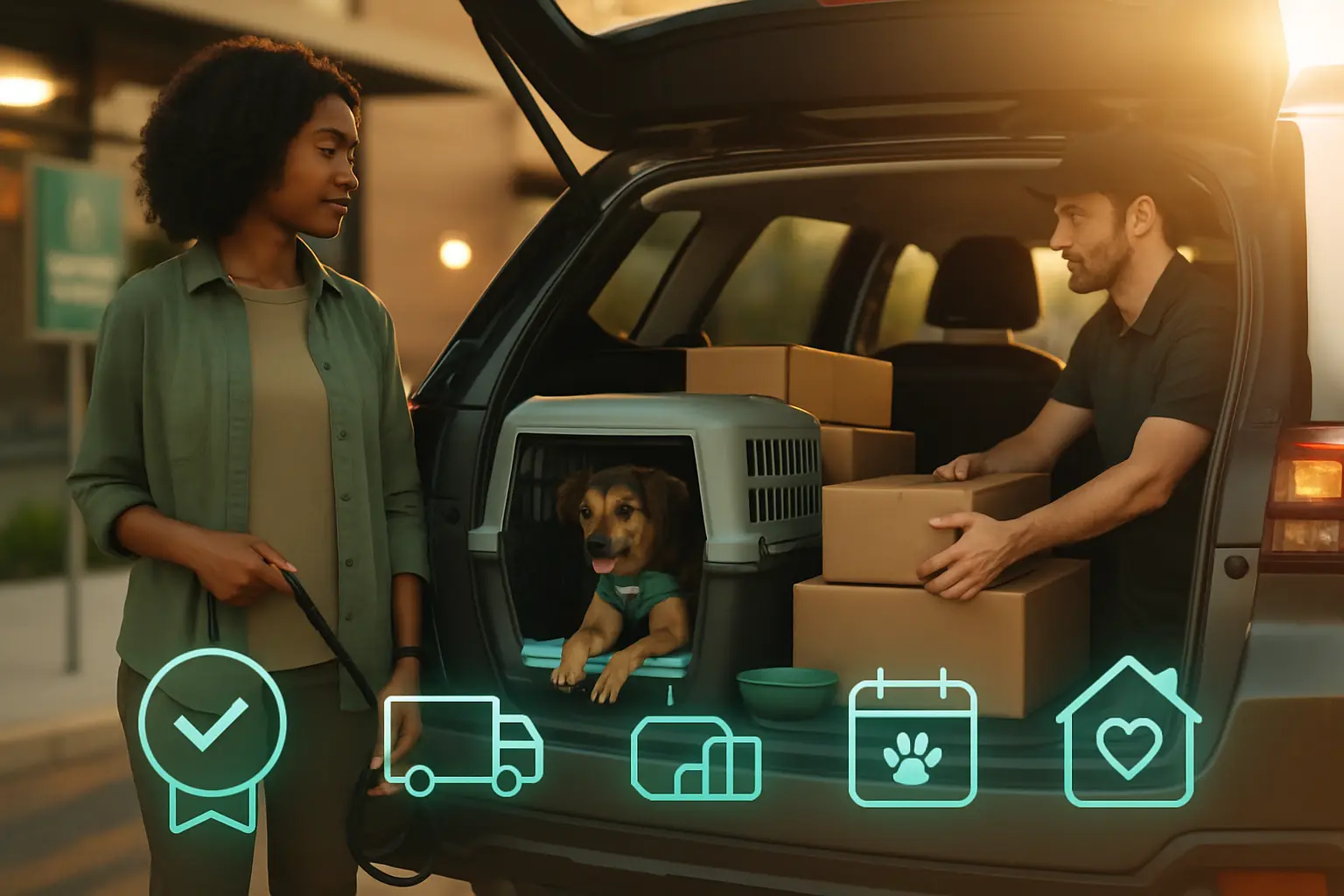
Cabela’s policies may prevent bringing a pet into the store. Fortunately, several practical alternatives let owners shop without disrupting their dog’s routine. Plan errands so the dog stays comfortable at home or with trusted care. For short trips, consider curbside pickup or home delivery to avoid leaving a pet alone for long.
When travel is required, vehicle-based solutions exist, but owners should avoid leaving a pet unattended in a car. For longer outings, secure a pet-sitter, day-care, or boarding facility. Many services offer drop-in visits for bathroom breaks and playtime.
Gear and preparation make alternatives easier. Pack familiar bedding, treats, and a favorite toy to reduce stress. For road or multi-stop days, consult resources on packing and travel logistics to streamline the process. See essential dog travel tips and gear for road trips for checklist ideas and gear recommendations.
Book alternatives ahead of time during weekends and holidays. A quick reservation prevents last-minute stress and ensures the dog receives consistent care.
Curbside pickup, online ordering and delivery options
Curbside pickup and online ordering remove the need to bring a dog inside. Many big-box retailers offer scheduled pickup windows. Choose a slot that keeps the dog’s routine intact. Confirm the store’s curbside process before arrival to avoid delays.
When ordering, select items eligible for same-day pickup or delivery. Delivery services range from store couriers to third-party apps. Compare fees and estimated arrival times. For large or heavy gear, consider professional freight delivery to the home.
For owners curious about store pet policies in general, comparing policies at different retailers helps set expectations. For example, see Are dogs allowed in Costco? to learn how other chains handle pets and curbside options.
Tip: designate a contact person to receive deliveries or pick up orders if the owner must run errands without their dog.
Local pet-sitters, daycares and temporary boarding options
Trusted in-person care often suits dogs better than leaving them alone. Local pet-sitters offer home visits that include walks, play, and feeding. Daycare centers provide supervised socialization and exercise for energetic dogs. Boarding kennels handle overnight stays with staff oversight.
Screen options by reading reviews, touring facilities, and verifying vaccination requirements. Ask about staff-to-dog ratios, emergency protocols, and how the facility manages behavioral issues. Arrange a trial day to observe how the dog adjusts.
Separation anxiety requires extra planning. Natural calming techniques, short practice absences, and consistent routines reduce stress. For owners seeking behavioral strategies, check 9 natural ways to remedy your dog’s travel anxiety.
Pack the dog’s food, medication, and a comfort item. Provide clear written instructions for the sitter. Book popular daycares and sitters in advance, especially on peak shopping days.
Using nearby pet-friendly outdoor spaces while you shop
When bringing a dog isn’t possible, pet-friendly outdoor spaces let owners keep the dog nearby and supervised. Look for fenced dog parks, shaded patios, and designated pet relief areas within walking distance of the store.
Safety matters. Never leave a dog tethered and unattended. If the dog waits outside, ensure constant supervision and quick access to water and shade. Shorten shopping time to limit stress.
Bring portable gear that improves comfort: collapsible water bowls, cooling mats, and a lightweight pop-up shade. For hot days, cooling options help prevent overheating. See practical product ideas at 10 refreshing puncture-proof dog pools for portable water solutions.
Plan errands so the dog can rotate between short supervised breaks and short car rest periods if necessary. Keep identification and a recent photo handy in case of separation.
How to prepare your dog for a shopping trip
Before bringing a dog into a retail store, owners should confirm the specific location’s pet policy and plan the visit to reduce stress. Many stores have different rules by state or franchise; a quick call or website check prevents surprises. Schedule the trip during off-peak hours to minimize exposure to crowds and loud noises. Exercise the dog before leaving; a brisk walk or short play session lowers excess energy and helps focus. Arrange transportation that keeps the dog secure, whether a crate, harness, or carrier, and confirm whether the store’s layout allows easy entry and exit without tight corridors or aggressive displays. Prepare an exit plan if the dog becomes anxious—identify a quiet spot in the parking lot or a nearby outdoor area. When planning multiple stops, prioritize the dog’s needs; limit shopping time to avoid fatigue. For additional practical travel gear and packing ideas, see essential dog travel tips and gear for road trips.
Training and socialization to reduce stress and prevent incidents
Basic obedience and steady socialization make retail outings safer. Owners should teach reliable cues: sit, stay, leave it, and a calm heel. Short, frequent training sessions build reliability under mild distractions before attempting a busy store. Socialization should expose the dog to different surfaces, noises, and strangers at a measured pace. Use controlled meet-and-greets with polite people and other calm dogs to reinforce positive behavior. For dogs prone to anxiety, practice brief public outings that mimic a store’s environment: crowded sidewalks, shopping cart noises, and fitted harnesses. Reward calm behavior with low-distraction treats and praise rather than punishment. If a dog shows mounting stress—panting, pacing, or focused avoidance—stop the session and return to easier steps. For owners seeking non-medical ways to ease travel-related nerves, consult resources like 9 natural ways to remedy your dog’s travel anxiety. Regular, incremental training reduces the chance of incidents and makes shopping smoother for everyone.
What to bring: leash, water, waste bags, vaccine records and ID
Packing the right items keeps the dog comfortable and compliant during a store visit. Bring a sturdy, non-retractable leash and a secure collar or harness with visible ID. Carry fresh water and a collapsible bowl to prevent dehydration during long trips. Pack waste bags and a small towel for quick cleanups. For some stores or states, showing vaccination records or proof of rabies vaccination can speed entry and avoid disputes; keep copies in a waterproof sleeve or on a phone. Include a lightweight mat or small blanket to give the dog a calm place to sit if staff allow it. For longer outings, bring favorite low-dust chews or a long-lasting treat to distract the dog without creating food fights. A compact first-aid kit with basic supplies helps handle minor scrapes. If crate travel is preferred, choose one sized for comfort and ventilation; recommendations and crate reviews can guide selection—see best dog crates for car travel. Pack these items in an easy-to-access bag so the owner can respond quickly to changing conditions.
Warning signs your dog shouldn’t go into a busy retail store
Owners must recognize clear signals that a dog should stay home. Aggressive displays—growling, snarling, snapping, or lunging—require avoiding public spaces until a trainer evaluates the behavior. Heightened fear signs include trembling, pinned ears, hiding behind the owner, or frenzied attempts to flee. Excessive vocalization that persists despite calming cues signals overstimulation. Physical distress—heavy panting, drooling, pale gums, excessive drooling, or collapse—demands immediate removal and possible veterinary care. If a dog freezes and cannot be redirected, the environment likely exceeds its coping threshold. Similarly, intact dogs with strong prey drives may react unpredictably to in-store animals or displays. When warning signs appear, the responsible choice is to leave the store and seek alternatives: a friend to wait in the car, pet daycare, or making the trip solo. For behavior about refusing entry or showing transport stress, review tips at dog refusing to get into car. Prioritizing safety prevents incidents and protects the dog and other shoppers.
Quick FAQs shoppers ask most often
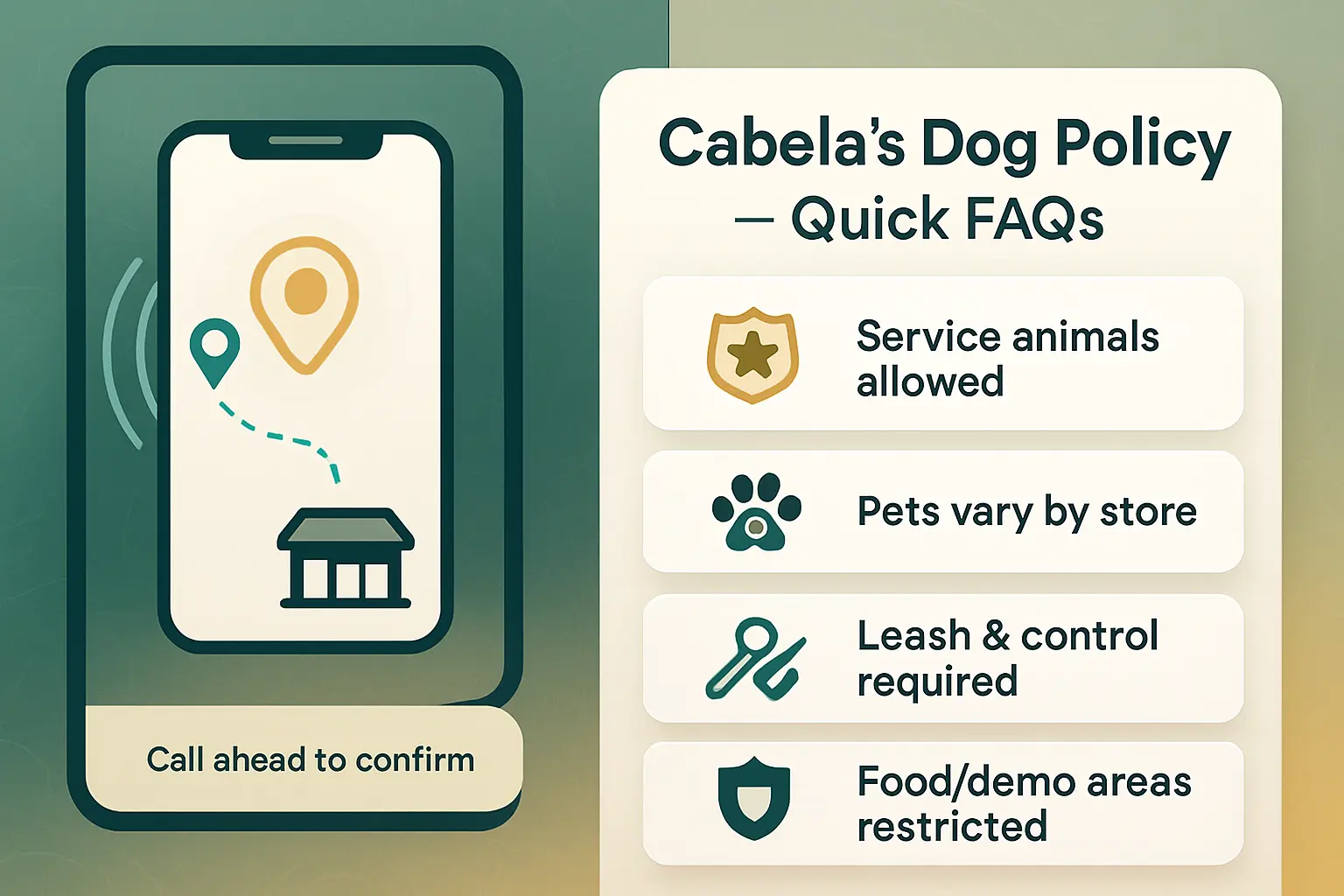
Many shoppers ask short, practical questions about bringing dogs to Cabela’s. Policies vary by location, so the safest step is to call the store before arriving. Most U.S. Cabela’s locations follow federal guidelines for public accommodations and generally permit service animals trained to perform specific tasks. Pet access beyond that depends on local store management and state health codes.
Other quick answers shoppers want:
- Leashes and control: If a store allows a pet, it must remain leashed or crated and under the owner’s control at all times.
- Health and cleanliness: Stores can restrict animals for hygiene or safety reasons, especially in areas with food service or demonstration events.
- Store-level exceptions: Individual managers can make reasonable accommodations or deny access when an animal poses a direct threat.
For a comparison of how major retailers handle pets and service animals, see this guide on other store policies: Are dogs allowed in Costco?
CTA: Call the specific Cabela’s location before bringing a dog to confirm rules and avoid surprises.
Are emotional support animals treated the same as service animals?
Under federal ADA rules, Cabela’s must allow dogs that qualify as service animals. A service dog performs a task directly related to a person’s disability, such as guiding, alerting, or pulling a wheelchair. Emotional support animals (ESAs) offer comfort but do not perform trained tasks. Stores typically do not receive the same legal requirement to admit ESAs.
Staff may ask only two questions when it is not obvious the dog is a service animal: whether the dog is a service animal required because of a disability, and what task the dog has been trained to perform. They may not request documentation, ask about the disability, or demand medical records.
State and local laws can add protections beyond federal rules, so policies vary. If a shopper expects to rely on an ESA, the recommended action is to contact the store in advance to discuss accommodations. For broader travel-related distinctions and rules about animal types, see airline policy comparisons at Airlines that allow large dogs in cabin.
Can very young or unvaccinated dogs be brought inside?
Stores often restrict animals that present health risks. Very young puppies and unvaccinated dogs raise concerns about communicable diseases and hygiene. Many retail locations, including outdoor and sporting goods stores, either prohibit unvaccinated animals or require proof of core vaccinations when local health codes apply.
Practical options for owners with young or unvaccinated dogs:
- Use curbside pickup or have someone else pick up items.
- Leave the dog secured in a vehicle when safe and legal to do so, following heat-safety guidelines.
- Bring a carrier or small crate for controlled transport in stores that permit it.
Preparing for travel or transport can help avoid conflicts; see travel and gear tips for safely moving young dogs in vehicles at Essential dog travel tips and gear for road trips.
What happens if a dog misbehaves or causes an incident in-store?
When a dog misbehaves, store staff prioritize customer safety and property protection. Typical responses include asking the owner to remove the dog immediately, issuing a warning, or banning the animal from future visits. If the dog bites or injures someone, staff will contact emergency services or animal control as required by law.
Owners remain legally responsible for their dog’s actions. The store can seek restitution for damage and may document the incident with witness statements and video. Repeated violations often lead to permanent bans from that location or chain-wide enforcement.
To reduce risk, owners should ensure dogs have basic obedience training, remain muzzled if required, and stay leashed and calm. If bringing a dog into public places poses behavior risk, consider leaving it home or arranging boarding. For guidance on handling disruptive behavior during travel, see this resource: What happens if my dog barks on a plane?
Practical pre-visit checklist and contact script
Before bringing a dog to Cabela’s, owners should verify store-specific rules and prepare for a smooth visit. Many locations allow pets in outdoor and some indoor areas, but policies vary by store and local regulations. Call the store or email ahead to confirm pet access, service-animal procedures, and any seasonal restrictions such as hunting demos or special events. Pack a short kit with leash, waste bags, water, a mat or towel, and a calming aid if the dog is noise-sensitive. Keep identification and vaccination records on hand when practical.
For road-ready planning and gear suggestions, the guide to essential dog travel tips and gear for road trips covers compact water bowls, secure travel crates, and comfort items that speed store visits. A quick call usually prevents surprises, and a polite, scripted inquiry saves time. If the store disallows pets, arrange a secure short-term alternative like a friend, pet-sitting service, or vehicle-safe setup nearby. Always prioritize the dog’s comfort and public safety when deciding whether to bring a pet inside.
One-line printable checklist to confirm before you go
One-line printable checklist: Leash & collar, ID & vaccinations, waste bags, water & bowl, mat/towel, crate or short tie option, store permission confirmed, service-animal paperwork (if applicable).
This compact line fits on a wallet card or phone note. Use it as a final review before exiting the car. If any item reads “no,” pause and resolve it—call home for forgotten ID, refill water, or confirm store exceptions. For guidance on safe travel containment and crate options that shorten store visits, consult the review of best dog crates for car travel. Keep the printed line visible to family members who may handle the dog during the trip.
Short phone/email script to ask a store about its dog policy
Phone script: “Hello, this is [name]. I plan to visit your store on [day/time]. Can you tell me whether pets are allowed inside? If not, are service animals accepted and what documentation do you require?”
Email script: “Hello—my name is [name]. I’m visiting your [city] store on [date]. Do you allow customers to bring dogs inside? If you permit service animals, please let me know any documentation or procedures to follow. Thanks for your time.”
Keep calls under one minute and emails under three sentences. Note the staff member’s name and any special instructions. If they reference safety concerns or restrictions, ask about nearby outdoor waiting areas or the best times to visit when the store is less busy. For additional tips on contacting venues and planning dog-friendly transit, see traveling with your dog by train tips and tricks. A brief confirmation call or email prevents refusals at the door and protects the dog’s welfare.
Summary
Are Dogs Allowed in Cabela’s? Complete Dog Policy, Exceptions & Tips clarifies that many Cabela’s locations welcome leashed, well-behaved pet dogs, but rules vary by store, state or province, landlord, and any on-site food-service areas. Service animals trained under the ADA must be admitted to public areas, while emotional support animals are treated as pets and may be restricted.
The guide shows shoppers how to verify store-specific rules, what etiquette and gear stores expect, and which zones typically remain off-limits. It also explains legal rights around service animals, how staff may interact, and practical alternatives—curbside pickup, delivery, sitters, or daycares—when a location can’t admit pets. The simplest way to avoid surprises: call the local Cabela’s before visiting.
Key Takeaways
- Policy varies by location: Many stores allow leashed, calm pet dogs, but local laws, mall leases, food-service areas, and events can limit access—always call ahead.
- Service animals are protected: ADA-trained service dogs must be admitted; staff may ask only two questions about the animal’s status and task—no documentation required. ESAs are treated as pets.
- Control and cleanliness are mandatory: Use a short, non-retractable leash, maintain control, clean up accidents, and leave if the dog becomes disruptive.
- Expect restricted zones: Pets are commonly barred from cafés/food counters, live-animal areas, firearms counters/ranges, and crowded demo spaces for safety and hygiene.
- Prepare and pack smart: Visit during off-peak hours; bring ID tags, water, waste bags, and a calm, well-socialized dog. Sick, soiled, or unvaccinated dogs may be refused.
- Use alternatives when needed: Choose curbside pickup, delivery, or trusted pet care; never leave a dog unattended in a vehicle.
FAQ
-
What is Cabela’s overall dog policy?
Many stores allow leashed, well-behaved pet dogs on the sales floor, while ADA service animals must be admitted. Because rules can change by state/province, landlord, and food-service areas, verify your specific store before visiting.
-
How do service animals differ from emotional support animals at Cabela’s?
Service dogs trained to perform tasks for a disability are allowed under the ADA; ESAs are treated as pets and may be restricted. Staff may only ask if it’s a service animal and what task it performs.
-
What areas are usually off-limits to pets and why?
Food counters/cafés, live-animal or aquarium sections, firearms counters/ranges, and some demos are commonly restricted for hygiene and safety reasons.
-
How should owners prepare a dog for a visit?
Call the store to confirm rules, go during off-peak hours, exercise the dog beforehand, and bring a short leash, water, waste bags, and ID. Keep the dog calm, controlled, and ready to leave if stressed.
-
Why might one store deny a pet while another allows it?
Local ordinances, mall or landlord policies, on-site food-service areas, seasonal events, or safety concerns can tighten rules. Managers may deny entry if an animal poses a risk or causes disruption.

